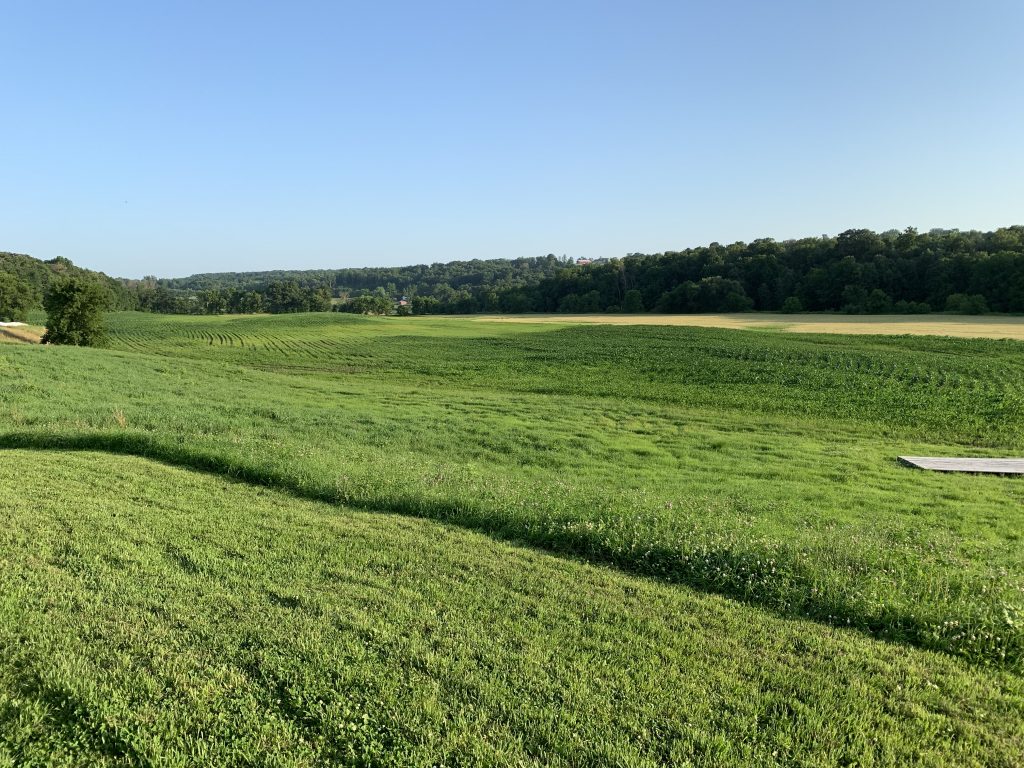This article highlights rural renewal and continuity in center of the country. It is based on a talk given by a young farmer who with her husband manage an organic farm in Decorah Iowa, which they describe “as growing organic crops, grazing sheep and cattle on pasture, powering their farm and home with the sun, and growing deep roots in our community.” They also run a diversified operation offering Friday night pizza parties that attract neighbors from near and far and offer a unique Glamping experience. Appropriately, these remarks were made at a recent dinner to benefit the Decorah Community Food Pantry.

Good evening. I’m Maren Beard. My husband Tom and I own and operate Luna Valley Farmhttps://www.lunavalleyfarm.com , which is located deep in a valley, about 8 miles north of Decorah Iowa. Maybe some of you have found your way out there for an Iowa Margherita or Peachy Pig pizza?
Last week we received a call from our neighbor, Paul Johnson. Paul is a former State Legislator, former Director of the National Resources and Conservation Service, https://congress.gov/congressional-record/1997/11/07/senate-section/article/S12041-3 former Director of the Iowa Department of Natural Resources and a retired farmer. He wanted to gift us his 1948 John Deere B tractor, the first tractor that he and his wife Pat purchased when they
moved from Chicago to Iowa in 1974 to start farming. I have to say, it was the first time that anyone ever called to offer us a tractor!
We made plans to visit Paul and Pat on Thursday morning, which happened to be our wedding anniversary. As we sat with them sipping coffee and sharing stories, Paul reminded us of his favorite Aldo Leopold quote. — “A farm is a portrait of the farmer.” Think about that for a minute – “A farm is a portrait of the farmer.” He shared with us that he’s proud of the portrait that he and Pat are continuing to paint on their farm and gave us the best anniversary gift we could imagine when he told us that he’s proud of the portrait that we’re painting on our farm.
Paul and Pat milked 15 Jerseys and had a flock of sheep. They shared machinery and labor with neighbors. (Side note: the very tractor that Paul and Pat gave us, was used to spread manure on our farm decades ago!). When everyone else was getting bigger and increasing dairy herds to 60-70 cows, they stayed small and diverse. As neighbors and friends went bankrupt during the farm crisis, Pat and Paul kept on planting trees, milking cows, growing a garden and investing in the soil. When the farm experts and extension agents wanted them to terrace their hillside to plant corn and soybeans, they instead planted trees and healed 22 gullies.

Tom and I began painting our portrait six years ago when we bought our farm from a neighbor who was born and raised there. We’ve taken down miles of rusty barbed wire fence, hauled away more than 200 tires and loads of mattresses, computer monitors and other junk that we inherited in our woods and pastures. The 100-year continuous corn cycle in our bottom field has been interrupted with plantings of hay, oats and peas. Rotationally grazing our sheep and cattle through our pastures has improved the grasslands, brought back the bobolinks and helped manage the buckthorn, parsnip and multiflora rose in our Burr Oak Savannah landscape.

When we purchased our farm, the barn had a big hole in the roof. The barn that now houses our pizza kitchen, pizza seating and has been featured in countless Instagram posts by pizza guests, would be on the ground had we not prioritized a new roof. At that time we had no thoughts of pizza nights on our farm but we love and respect old buildings and the history they hold so we made an investment. We’re working hard to continue painting a portrait on our farm that reflects who we are and what we value.
A farm might be the portrait of the farmer but the agricultural landscape in this place is very much a portrait of the community. After all, you are the eaters who support what we, as farmers do. What kind of a portrait do you want to paint? What kind of a portrait do you want your children and grandchildren to see as they walk, bike, canoe and drive around this beautiful place? All of you who are seated here tonight can help create habitat for butterflies and pollinators, heal gullies and contribute to vibrant agricultural economies and landscapes through buying groceries. In fact, you have at least three opportunities to paint this portrait each and every day.

Tonight, as you eat tomatoes and greens from River Root Farm, apples from Peake Orchard, grass fed beef from Luna Valley Farm and root vegetables from Patchwork Green, you are both painting a portrait of a more beautiful and diverse agricultural landscape, and ensuring that everyone in our community can be part of that portrait by increasing food access.
Thank you.
Maren Beard
After a youth spent in rural Wisconsin Maren attended Luther College in Decorah where she studied Environmental Studies and Spanish. She fell in love with the area and went on to earn a Masters of Science in Sustainable Food Systems and joined the team at Luther College as the Assistant Director for the Center for Sustainable Communities. Maren enjoys hanging out with the sheep, hosting dinner parties, growing vegetables and traveling the world.
Decorah Heritage Dinner Talk
September 8, 2019



One Response
This illustrates how both nature and culture can be harmoniously promoted and preserved by thoughtful, hardworking people, with results that are a feast for our eyes and for our stomachs.
We need to hear more from the likes of Maren&Tom, and Paul&Pat.